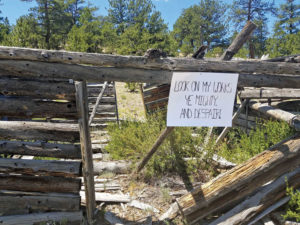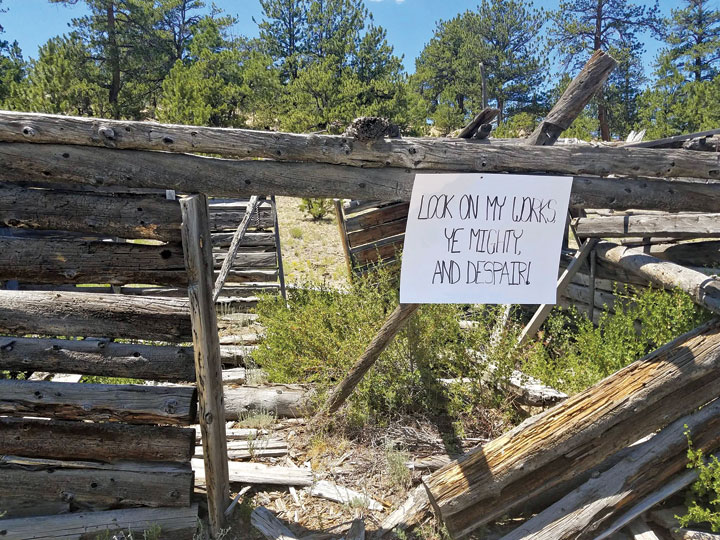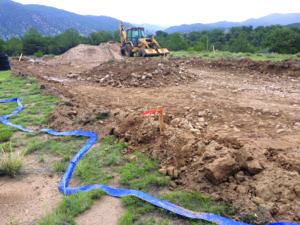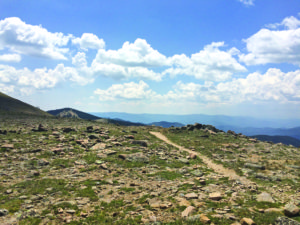By Jan MacKell Collins
No, no, not that Trump. His Donaldness has not made a visit to our fair state since before his election, back when he was just a paltry billionaire seeking our votes. He might come to Colorado again, but something really catastrophic needs to occur for that to happen – like a bunch of terrible wildfires, or even some horrific flash floods. Maybe then the president might show up, and even express a little sympathy. Maybe.
Anyway, I digress. The Trump in this case was actually a family-oriented post office community that once existed right here in Park County, in southwestern South Park. Don’t worry; there is no evidence even remotely suggesting that Donald’s grandpa ran a boardinghouse for shapely young ladies here. That was relegated to the Pacific Northwest, and as far as we know, none of Trump’s ancestors pioneered in Colorado. The place was simply known as Trump, although a few people wish there was more to it than that.
For the record, Colorado is also home to Mount Pence and Clinton Peak. There also is a Republican Mountain and Mount Democrat. And let’s not forget American Flag Mountain. These places, as well as Trump, have heightened the senses of those politically charged folks who want to, well, make something out of nothing; no matter how nothing it is. Take the “El Paso County Young Democrats,” a nice looking young group of people from Colorado Springs. From their Facebook page, the bunch documented their field trip to Trump last July. The excursion included lunch and “funny protest signs” to commemorate the trip. We can only hope that the signs accompanied the group back home once they left the old town.
[InContentAdTwo]
And so, on to Trump, Colorado, whose population never amounted to much, but still remained an important community in Park County’s ranching history. The place was located some fifteen or so miles from Hartsel, right in the middle of cattle country. Like so many remote outposts, Trump served as a community center for numerous ranches in the area. That in itself makes Trump important, as the centralized location provided a store, a school, and beginning in May of 1928, a post office. The only known postmaster was Gus Woodburn.

All around Trump, in a wide circle of high prairie and forest land, lay various ranches. They were as large as the Colorado Land & Livestock Ranch, with its forty-something employees living in one large bunkhouse, and as small as the spread of Thomas Davis whose only neighbor was gold miner Russell Larson. For those living far out on the high plains, a trip to Trump meant the chance to visit with neighboring ranchers, catch up on local gossip, purchase a few dry goods, and check the mail. Local children spent their only playtime in between lessons at the school, for most had chores to do once they got home.
Even after Trump’s post office closed in November of 1931, certain members of the tightly-knit community chose to stick around and simply get their mail at Hartsel. Descendants of the Makings family, who ran the store form 1932 to 1940, remember the local ranch hands gathering for their own rodeo competitions which took place at Trump. There were other families too: The McClains, Underhills, Childresses and more. Although they say the population was down to just three people by 1936, the 8th grade school picnic in April that year was attended by six students alone. Around that time, a finely dressed lady with the whimsical name, Vongells Wilmont, was employed as their teacher.
Trump survived into the early 1940s. After that, the name faded even as many ranchers remained in the area. Eventually Trump’s buildings were abandoned as better automobiles made for easier transportation between the region and Hartsel. Today, only skeletons of the buildings remain at Trump, and visitors should be aware of the private homes and livestock ranges along the roads leading there. The name does live on in a unique sandstone clump that was identified in 1937. The formation, called the “Trump Conglomerate,” is partially described as consisting “of gravel, poorly cemented.” Huh. Sounds familiar. ?
Jan MacKell Collins still affiliates with the Whig party when she registers to vote, the same as her great-great-great uncle Zachary Taylor did.



